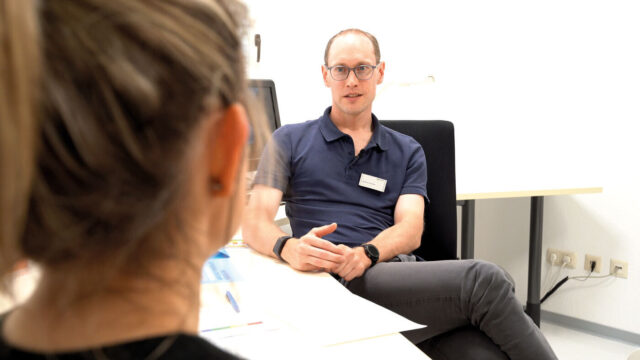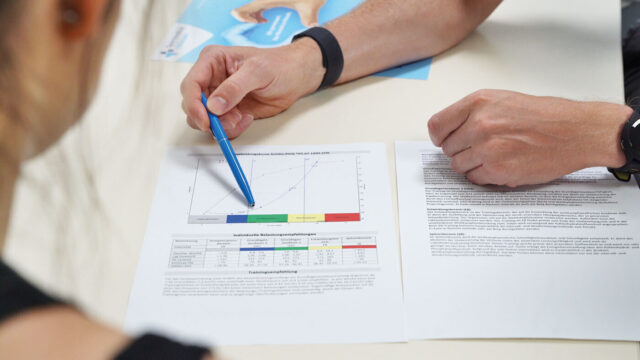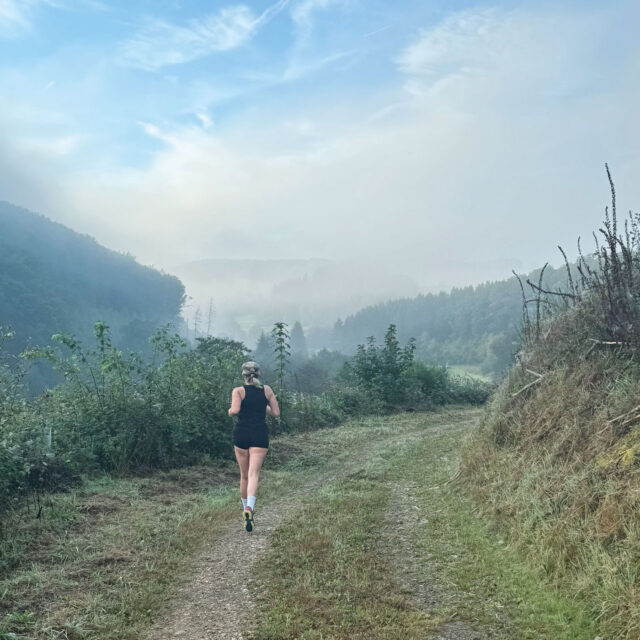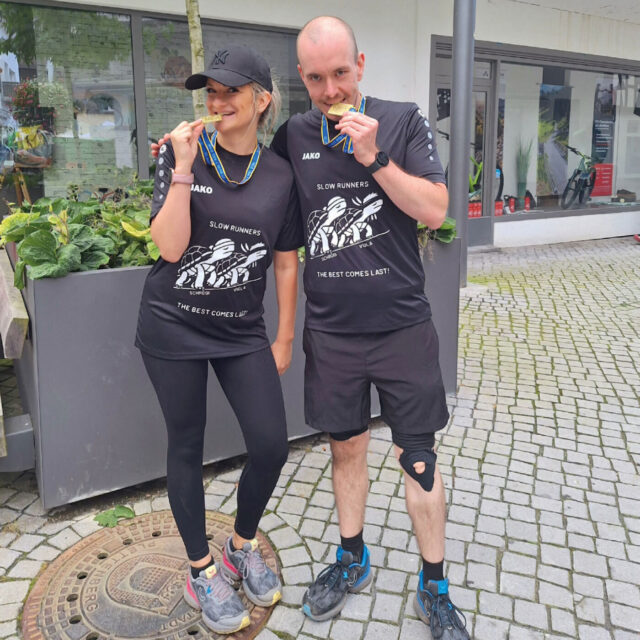Get ready for the P-Weg with Sportmedizin Hellersen

Have article read aloud
A crazy idea? Maybe. But with the right plan, it becomes a success!
Just a few months ago, I could hardly have imagined ever running a half marathon. Regular running training was a foreign concept to me, and when I laced up my worn-out running shoes for the first time three months ago, I couldn't manage a single kilometer. But sometimes all it takes is a crazy idea to completely turn your everyday life upside down.
Video: The right way to run a half marathon
In search of a new challenge, I came across the P-Weg Marathon in Plettenberg, which celebrated its 20th anniversary last year. What I didn't realize at the time was that the half marathon through the four valleys is really tough: 21.1 kilometers through picturesque low mountain ranges, 540 meters of elevation gain, and terrain consisting mainly of forest and gravel paths. What initially sounded like a sporting experiment soon turned into a serious mission. To prepare myself as well as possible for the running event, I sought expert support at Sportmedizin Hellersen.
“Managing twelve kilometers after three months is already a huge achievement.”
Dr. Ulrich Schneider
Chief of Sportmedizin Hellersen
The anamnesis interview – the most important part of the sports medicine examination
As part of the sports medicine examination, Dr. Ulrich Schneider, Chief of Sportmedizin Hellersen, first conducts a detailed anamnesis interview with me – the most important part of the examination. He asks precise questions about my training habits, my previous running performance, and any health restrictions. He is particularly interested in how I am preparing for the challenging elevation gain of the P-Weg Half Marathon—an aspect I had previously underestimated. I admit that I don't have any exact data and that I mainly train on slightly hilly terrain, such as dams or in the forest.
So far, I have only tackled steep climbs by walking quickly. I have already managed twelve kilometers several times during training, but without any significant elevation gain.
“That's perfectly fine,” the sports physician encourages me. ”Managing twelve kilometers after three months is already a huge achievement.”
Explanation of the training areas
Compensation range (KB)
- Goal: Recovery after intense workouts
- Metabolism: Fat burning
- Type of training: Continuous method
- Duration: 30 to 45 minutes
- Terrain: Flat
Basic endurance 1 (GA1)
- Goal: Improvement of endurance and cardiovascular performance
- Metabolism: Fat burning
- Training method: Continuous method
- Terrain: Flat to slightly hilly
- Use: All year round, especially in the preparation phase
Basic endurance 2 (GA2)
- Goal: Improve endurance and capillary formation
- Metabolism: Burn fat with more carbohydrates
- Training method: Continuous training and extensive interval training
- Terrain: Flat or hilly
- Use: Preparation and competition phase
Development area (EB)
- Goal: Improving endurance for competitions
- Metabolism: Carbohydrates, lactate elimination
- Training method: Intensive interval method and competition simulation
- Terrain: Flat or hilly
- Use: End of preparation period and competition preparation
Top range (SB)
- Goal: To improve speed and anaerobic performance
- Metabolism: Carbohydrates and phosphate
- Training method: Intensive interval method
- Terrain: Flat or hilly
- Use: Competition preparation
He asks me specific questions to assess my physical condition and health. Susceptibility to infections, allergies, previous illnesses, family illnesses, sleeping habits, medication—nothing seems to stand in the way of my goal. Only my initial naivety and starting out with worn-out running shoes came back to haunt me: painful ankle inflammation forced me to take a break. I solved the problem by buying the right running shoes.
“These are classic beginner's problems,” explains Dr. Schneider, emphasizing how important it is to increase the load gradually to avoid overexertion. He praises my progress so far and is optimistic that I can master the challenge of the P-Weg if I continue to train consistently.
The sports medicine examination is not only used to assess performance, but also for prevention: “We want to ensure that there are no health risks and that your musculoskeletal system can cope with the increased strain,” emphasizes the sports physician. He is particularly pleased that I am less prone to illness thanks to the training—an effect that has already been proven by sports medicine studies.
From orthopedic analysis to stress testing
After the medical history interview, the internal medicine and orthopedic examination continues: Dr. Ulrich Schneider measures my blood pressure, listens to my heart, and carefully checks my joints and muscles. Sports scientist Andreas Kramer then uses a body fat scale to determine my weight, body mass index (BMI), and body fat percentage. At 56.9 kilograms, 162.5 centimeters tall, with a BMI of 21.5 and a body fat percentage of 22.3%, I am in the optimal normal range for adults.
The tests are followed by a resting ECG, which measures my heart activity while I am relaxed. Electrodes record the electrical impulses of the heart to check whether it is beating regularly. This allows any abnormalities, such as cardiac arrhythmia or signs of strain, to be detected at an early stage.
For the stress ECG, I then get on the treadmill. A breathing mask measures my oxygen consumption and carbon dioxide output, while an ECG device monitors my heart rate and rhythm. Additional sensors record my pulse and blood pressure as the intensity of the workout is gradually increased.
A key component of the stress ECG is lactate measurement. While I run, a drop of blood is taken from my earlobe at regular intervals to determine the lactate level. This value shows how my body builds up lactic acid (lactate) during exercise and helps to determine my anaerobic threshold—the point at which lactate build-up and breakdown are just balanced. Rising lactate levels indicate that the exercise is becoming more intense and fatigue is setting in.

Clear training recommendations for competitive success
“The lactate values show us how strenuous the training is for your body,” explains Andreas Kramer in the follow-up discussion. ”The results from the test clearly show that you still have a very low lactate value at low intensity, for example at a speed of 7.6 km/h. This means that you are in a moderate training zone where your body tends to burn fat.”
In the middle range, at slightly higher speeds, the body will rely more on carbohydrates, which is a crucial basis for more intensive interval training. “For the P-path, it is important that you stay in the so-called development zone during individual training sessions, as this is where you can build up your competition-specific endurance and develop the strength you need for climbs and altitude,” explains the sports scientist. It is crucial that the training is not too intense, but rather remains in the moderate range in order to promote fat metabolism and cover long distances efficiently.
Your heart rate plays an important role here. “Your goal should be to stay below a heart rate of 160 to optimize your fat metabolism. If you're below 160, you can run longer and thus train the necessary endurance,” he explains. Special attention should be paid to combining interval training with longer, less intense training sessions. “You should incorporate interval training once a week to increase the intensity and improve your performance on steep climbs,” advises Andreas Kramer, adding: ”Interval training should be designed so that you challenge yourself intensively but don't overexert yourself. For the P-trail, it's important to also train specifically for the uphill and downhill sections.
In addition, I should not experiment with my diet during training, but rather provide my body with the nutrients it needs. Especially during intense workouts, the focus should be on carbohydrates to provide the necessary energy. Immediately after training, it is crucial to consume carbohydrates and fluids quickly to promote recovery and get the body ready for the next workout. Your diet should be balanced and healthy, but shortly after training, it is important to replenish your carbohydrate stores quickly. Before intensive training sessions, it is advisable to add carbohydrates – and if necessary, also during the session, for example in the form of bars or gels. Especially during interval training, your legs can react with fatigue, and additional energy can then be very helpful. For longer, more relaxed sessions, I should also eat enough in the days before so that I can easily manage the 90 minutes without additional food.


Ready for the P-Weg – no pain, no gain
I leave the sports medicine clinic feeling optimistic and start the real work: implementing the training recommendations. I notice my difficulties particularly during interval training, whereas long-distance runs are easy for me and fun. Nevertheless, I torture myself once a week by running up the Herscheid mountains to prepare myself optimally for the challenges of the P-Weg. After three weeks, I notice that the climb is getting easier and easier and I can run up the hill for 10 minutes without stopping. The training is getting better and better each time and I feel ready for the challenge.
Then, four weeks before the big running event, it happens: I come down with a bad case of the flu. Running training is out of the question. Even after I recover from the infection, I notice how difficult the training still is. About a week before the P-Weg, however, I want to find out once and for all – can I do it or can't I? Together with a friend who has already run the P-Weg once, I run the route. The result: it was totally exhausting, and I had doubts as to whether I could really do it. But in the end, I was incredibly happy to have mastered the route. It felt like a huge success, even though I knew that the actual competition was still ahead of me.
A few days before the running event, I received some more good news: a friend who had already been supporting me intensively during training had recovered from his knee injury and was able to register for the P-Weg at short notice. Since it's easier to run with a partner, I was incredibly grateful for this support. To be as well rested as possible, I went to bed early the night before and, despite my nervousness, slept surprisingly well. I also followed the sports scientist's recommendation to start both training and the competition with full carbohydrate reserves and ate a high-calorie breakfast.
“For the P-Weg, it is important to also train specifically for the uphill and downhill sections.”
Andreas Kramer
Sports scientist, Sportmedizin Hellersen

The highs and lows of the running event
With my running shoes tightly laced and plenty of glucose and gel in my bag, I head to the starting point in Plettenberg town center. After the starting signal, we run through the town center, past the cheering crowds, until we reach the first hill. I walk up this hill at a fast pace, as I know from my previous trial run that I won't be able to run up it. I need the energy I've saved to complete the entire 21.1 kilometers.
The first 4.5 kilometers to the first aid station are relatively easy for me – nevertheless, I take Andreas Kramer's advice and drink a Coke to help me get through the next few kilometers. We continue towards the district of Landemert until we dive back into the forest, where the next challenge awaits me after a few kilometers: the Bärenberg.
At a height of 498 meters, it is considered a real test for all P-Weg runners. After I have managed the climb, the route goes steeply downhill. The trail continues through the picturesque landscape to the last refreshment station at Tanneneck. Here I notice how my strength is slowly fading. The last 5.2 kilometers are still ahead of me. Back in the forest, my reserves are almost exhausted. I notice this especially when the trail descends – a real test of endurance for my tired legs. However, the last few meters to the finish line are without any major difficulties. Exhausted but happy, I reach the event stage, where a medal and refreshments await me. Originally, my only goal was to complete the half marathon, but I was still aiming for a time of 2:30 hours. With a time of 2:36 hours for the challenging, mountainous course, I am very satisfied and proud of my performance – especially for my first half marathon.
Dr. Ulrich Schneider
Chief of Sports Medicine / Internal Medicine
Whether performance and check-up examinations or squad testing for sports teams – competitive and elite athletes are regular visitors to Sportmedizin Hellersen. Amateur and recreational athletes as well as those new to sport also benefit from this expertise. Sports scientists and doctors examine endurance levels, check posture, and measure strength to identify any deficits and, if necessary, work together to develop a training plan tailored to each individual's personal goals and abilities. Sports medicine is the point of contact for athletes who want to optimize their performance, as well as for beginners or those returning to sport, for example to rule out risk factors for the cardiovascular system. Patients with conditions that primarily require a medical examination under stress are also in the right place at Sports Medicine.
Treatment focus
Internal medicine and orthopedic sports medicine
- Sports Medicine / internal medicine
- Sports medical examination
- Performance diagnostics
- Bioimpedance analysis
- Sports science consulting and training planning
































